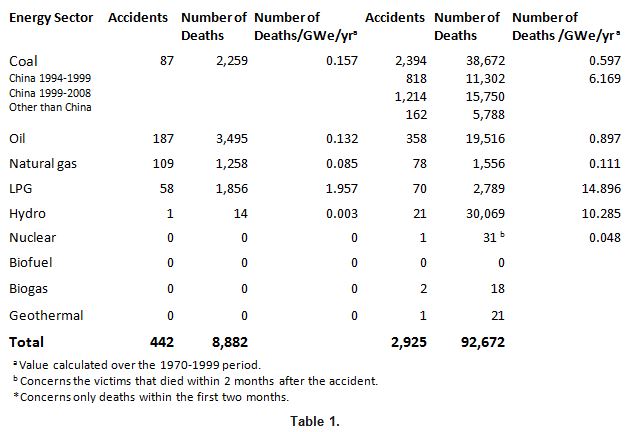By Jean Pierre Schwartz and Roland Masse
French translation by Elisabeth Huffer
Keywords : Fossil Fuels; Nuclear Power, Wind and Photovoltaic (PV) Power; Air Pollution and Health
Energy in all its forms is an essential element of life in our societies. However, along with the many benefits it provides, every stage of its implementation has negative repercussions.
At a time when a growing sensitivity is developing to control and reduce the consequences of human activities that are detrimental to the environment, the production and use of energy are subjected to close scrutiny. Similarly, weighing the various sources of energy involved with regard to their impacts on public health proves to be essential.
Such is the objective of the document written by Roland Masse, “Health Costs of Energy”, published on the website of Sauvons le climat : download complete pdf document .
We present here an overview of the findings detailed in the above-mentioned document.
full html version : https://www.sauvonsleclimat.org/en/presentation-en/scientific-studies/health-impact-different-energy-sources
Translation of "Les impacts sanitaires des différentes sources d'énergie"
- Severe Accidents Due to Energy Production – Table 1.
Severe accidents are those that involve at least: 5 premature deaths; or 200 evacuees; or 10,000 tonnes of fossil fuel spill; or a ban on the consumption of local products.
Table 1 provides an assessment of these, covering the 1970-2008 period [1].
*Concerns only deaths within the first two months.
Table 1.
These values count direct, short-term deaths; the deferred effects, whose evaluation can involve a great deal of uncertainty, should be added to these:
- For coal, from 1946 to 1986 in France, silicosis was a causing factor in the death of 20% of the coal miners, i.e. 80,000 to 120,000 persons [2]; in China, more than 500,000 miners were affected.
- For nuclear energy, the majority of the deaths occurs with a delay of up to 50 years after the accident for radio-induced pathologies (cancers, cardio-vascular diseases…up to 33,000 premature deaths, the maximum estimated amount for Chernobyl [3]) and for post-traumatic stress and deteriorated post-accident living conditions (2,000 premature deaths attributed to Fukushima [4]).
Not much data is available concerning wind and photovoltaic energies; for the latter, an order of magnitude of 10-3 deaths/GWe-yr is mentioned.
2. Impacts on Health of the Production and Use of Electricity – Table 2.
European and American research studies provide an overview of the health impacts due to the different electricity production sources. Table 2 gives, for Europe, the damage suffered, expressed in life years lost per TWh after the year 2000 [5].
|
Coal |
Fuel Oil |
Gas |
Nuclear |
Biomass |
Wind |
PV |
|
122 |
150 |
32 |
9 |
77 |
6 |
12 |
Table 2. These repercussions result from problems specific to each source:
- Nuclear energy induces external and internal overexposure to ionizing radiation. An excess dose can lead to cancer; their probability of occurrence has been evaluated. In those domains where the uncertainty is large, dose-effect correlations have been formalized in order to establish standards and allow estimates;
- Carbon-based energy sources, including biomass, emit CO2 causing global warming and its repercussions on health; they also release toxic compounds, which appear in a gaseous phase, such as SO2, nitrogen oxides NOx and ozone; or in a particulate phase, the particulate matter being classified according to their size (PM10 smaller than 10μm, PM2.5, ultrafine particulate matter ...); pollution due to metals must also be taken into account. The health impacts reported vary in nature: pulmonary, cardiac, vascular diseases, and cancer. An analytic assessment of the impact of each pollutant is difficult: epidemiological studies are unable to isolate individual causes, given that the pollutants in the mixture can interact and thus modify each other's effect.
- Renewable sources of energy, wind and photovoltaic, pollute essentially in the non-production phase of their life cycle when fossil fuels are used.
3. Which energy source to preserve public health?
The importance of the frame in which society evolves is manifest at first sight. The existence of demanding standards and compliance with them protects populations as can be seen with the gap between OECD and non-OECD countries regarding the onset of accidents and their outcome.
The energy sources can be grouped in 2 categories:
- carbon-based energies, the more toxic of the 2, with fossil fuels, coal, oil, gas, but also renewable biomass;
- Nuclear energy and carbon-free renewable energies, hydroelectric, wind, and solar.
A factor of 3 to 10 on the health impacts emerges between the 2 groups, to the detriment of carbon-based energies.
Thus, nuclear energy and carbon-free renewable energies emerge as the most favorable sources to efficiently limit damage on health. The convergence with their position as best environmental safeguards proves complete, with the elimination of CO2 emissions, one of the main contributors to global warming.
References
[1] a-Hirschberg et al.: Severe accidents in the Energy Sector 1st Edition Swiss Federal Office of Energy 1998
b-Burgher P, Hirschberg S.: Comparative risk assessment of severe accidents in the energy sector. Energy Policy, 74, 2014, S45-S56.
[2] Rosental PA. : La silicose comme maladie professionnelle transnationale. Revue Française des Affaires Sociales 2008/2 La Documentation Française
[3] United Nations Scientific Committee on the effect of Atomic Radiations : Sources and Effects of Ionizing Radiations United Nations 2008
[4] The Japan Times Feb 20 2014
[5] Rabl A Spandaro J.: Les coûts externes de l’électricité, Revue de l’énergie, 525, 151, 2001





